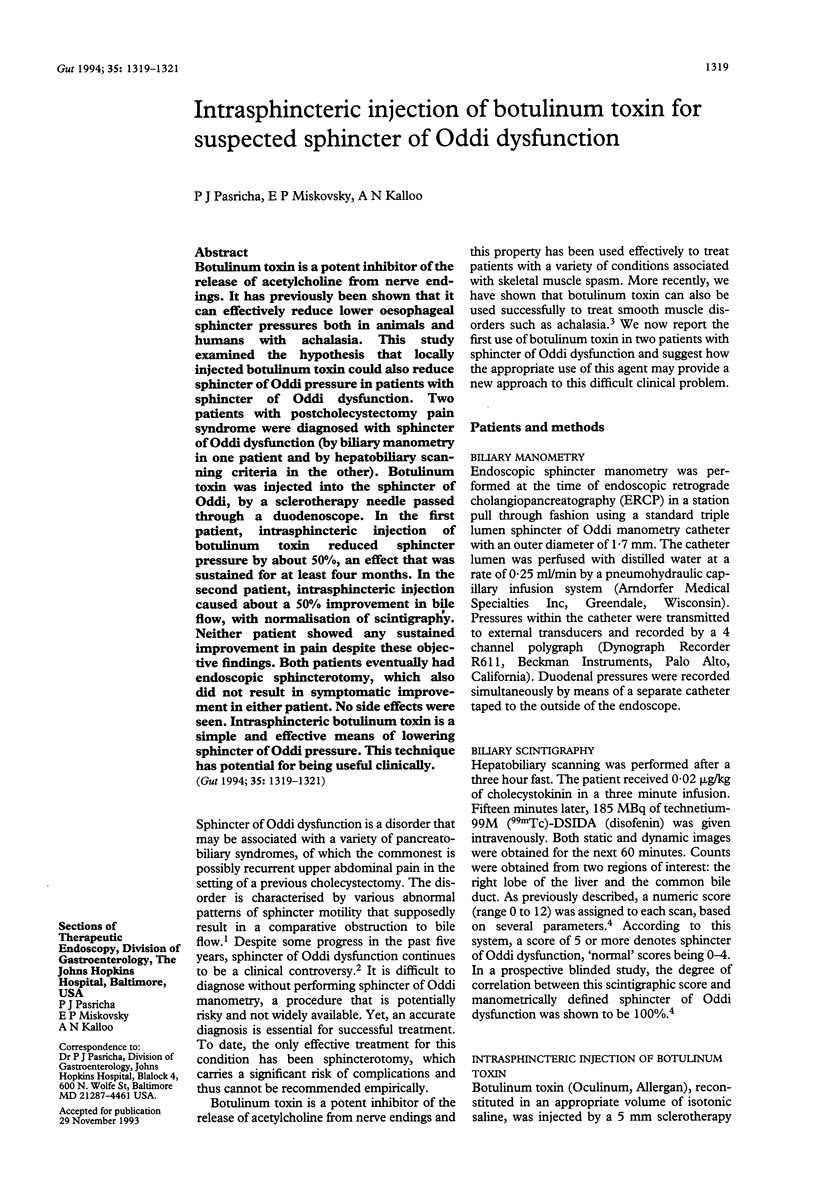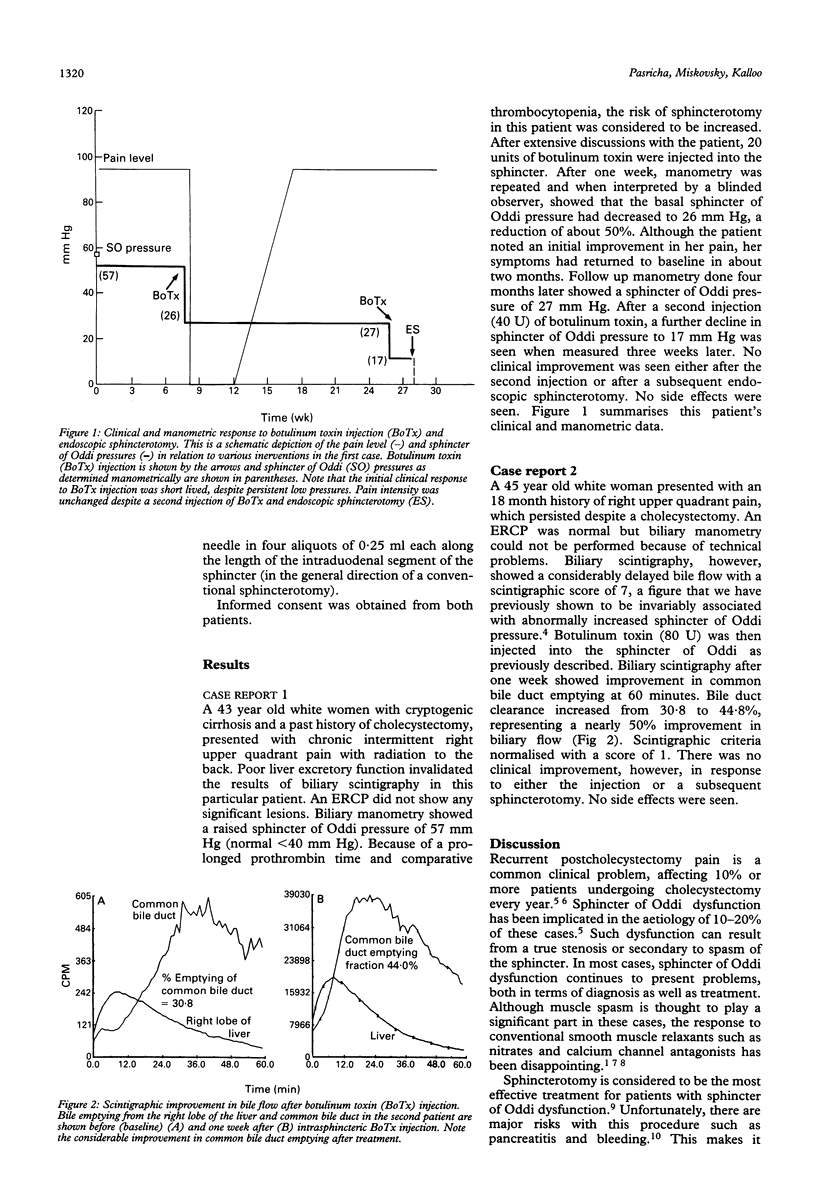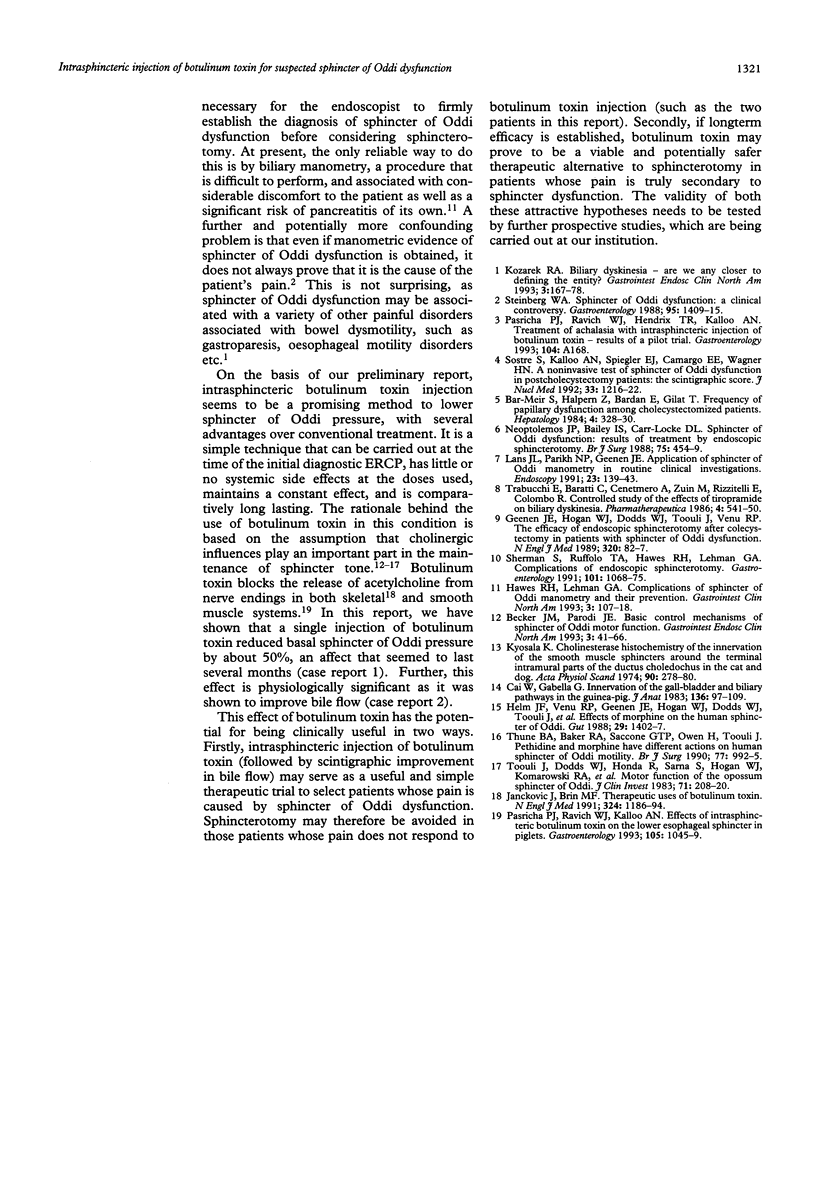Abstract
Botulinum toxin is a potent inhibitor of the release of acetylcholine from nerve endings. It has previously been shown that it can effectively reduce lower oesophageal sphincter pressures both in animals and humans with achalasia. This study examined the hypothesis that locally injected botulinum toxin could also reduce sphincter of Oddi pressure in patients with sphincter of Oddi dysfunction. Two patients with postcholecystectomy pain syndrome were diagnosed with sphincter of Oddi dysfunction (by biliary manometry in one patient and by hepatobiliary scanning criteria in the other). Botulinum toxin was injected into the sphincter of Oddi, by a sclerotherapy needle passed through a duodenoscope. In the first patient, intrasphincteric injection of botulinum toxin reduced sphincter pressure by about 50%, an effect that was sustained for at least four months. In the second patient, intrasphincteric injection caused about a 50% improvement in bile flow, with normalisation of scintigraphy. Neither patient showed any sustained improvement in pain despite these objective findings. Both patients eventually had endoscopic sphincterotomy, which also did not result in symptomatic improvement in either patient. No side effects were seen. Intrasphincteric botulinum toxin is a simple and effective means of lowering sphincter of Oddi pressure. This technique has potential for being useful clinically.
Full text
PDF


Selected References
These references are in PubMed. This may not be the complete list of references from this article.
- Bar-Meir S., Halpern Z., Bardan E., Gilat T. Frequency of papillary dysfunction among cholecystectomized patients. Hepatology. 1984 Mar-Apr;4(2):328–330. doi: 10.1002/hep.1840040225. [DOI] [PubMed] [Google Scholar]
- Cai W. Q., Gabella G. Innervation of the gall bladder and biliary pathways in the guinea-pig. J Anat. 1983 Jan;136(Pt 1):97–109. [PMC free article] [PubMed] [Google Scholar]
- Geenen J. E., Hogan W. J., Dodds W. J., Toouli J., Venu R. P. The efficacy of endoscopic sphincterotomy after cholecystectomy in patients with sphincter-of-Oddi dysfunction. N Engl J Med. 1989 Jan 12;320(2):82–87. doi: 10.1056/NEJM198901123200203. [DOI] [PubMed] [Google Scholar]
- Helm J. F., Venu R. P., Geenen J. E., Hogan W. J., Dodds W. J., Toouli J., Arndorfer R. C. Effects of morphine on the human sphincter of Oddi. Gut. 1988 Oct;29(10):1402–1407. doi: 10.1136/gut.29.10.1402. [DOI] [PMC free article] [PubMed] [Google Scholar]
- Jankovic J., Brin M. F. Therapeutic uses of botulinum toxin. N Engl J Med. 1991 Apr 25;324(17):1186–1194. doi: 10.1056/NEJM199104253241707. [DOI] [PubMed] [Google Scholar]
- Kyösola K. Cholinesterase histochemistry of the innervation of the smooth muscle sphincters around the terminal intramural part of the ductus choledochus in the cat and the dog. Acta Physiol Scand. 1974 Jan;90(1):278–280. doi: 10.1111/j.1748-1716.1974.tb05587.x. [DOI] [PubMed] [Google Scholar]
- Lans J. L., Parikh N. P., Geenen J. E. Application of sphincter of Oddi manometry in routine clinical investigations. Endoscopy. 1991 May;23(3):139–143. doi: 10.1055/s-2007-1010641. [DOI] [PubMed] [Google Scholar]
- Neoptolemos J. P., Bailey I. S., Carr-Locke D. L. Sphincter of Oddi dysfunction: results of treatment by endoscopic sphincterotomy. Br J Surg. 1988 May;75(5):454–459. doi: 10.1002/bjs.1800750518. [DOI] [PubMed] [Google Scholar]
- Pasricha P. J., Ravich W. J., Kalloo A. N. Effects of intrasphincteric botulinum toxin on the lower esophageal sphincter in piglets. Gastroenterology. 1993 Oct;105(4):1045–1049. doi: 10.1016/0016-5085(93)90947-b. [DOI] [PubMed] [Google Scholar]
- Sherman S., Ruffolo T. A., Hawes R. H., Lehman G. A. Complications of endoscopic sphincterotomy. A prospective series with emphasis on the increased risk associated with sphincter of Oddi dysfunction and nondilated bile ducts. Gastroenterology. 1991 Oct;101(4):1068–1075. [PubMed] [Google Scholar]
- Sostre S., Kalloo A. N., Spiegler E. J., Camargo E. E., Wagner H. N., Jr A noninvasive test of sphincter of Oddi dysfunction in postcholecystectomy patients: the scintigraphic score. J Nucl Med. 1992 Jun;33(6):1216–1222. [PubMed] [Google Scholar]
- Steinberg W. M. Sphincter of Oddi dysfunction: a clinical controversy. Gastroenterology. 1988 Nov;95(5):1409–1415. doi: 10.1016/0016-5085(88)90381-2. [DOI] [PubMed] [Google Scholar]
- Thune A., Baker R. A., Saccone G. T., Owen H., Toouli J. Differing effects of pethidine and morphine on human sphincter of Oddi motility. Br J Surg. 1990 Sep;77(9):992–995. doi: 10.1002/bjs.1800770911. [DOI] [PubMed] [Google Scholar]
- Toouli J., Dodds W. J., Honda R., Sarna S., Hogan W. J., Komarowski R. A., Linehan J. H., Arndorfer R. C. Motor function of the opossum sphincter of Oddi. J Clin Invest. 1983 Feb;71(2):208–220. doi: 10.1172/JCI110761. [DOI] [PMC free article] [PubMed] [Google Scholar]
- Trabucchi E., Baratti C., Centemero A., Zuin M., Rizzitelli E., Colombo R. Controlled study of the effects of tiropramide on biliary dyskinesia. Pharmatherapeutica. 1986;4(9):541–550. [PubMed] [Google Scholar]


